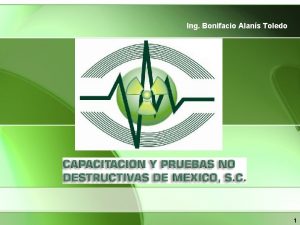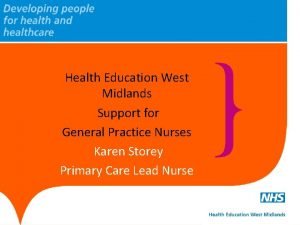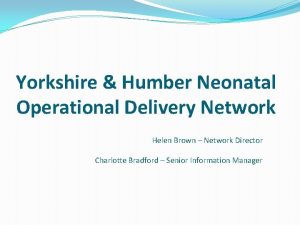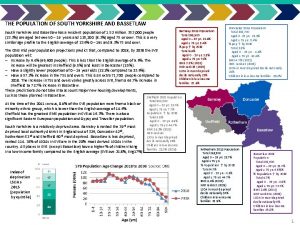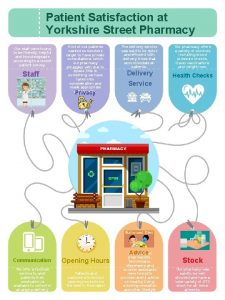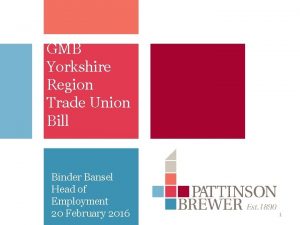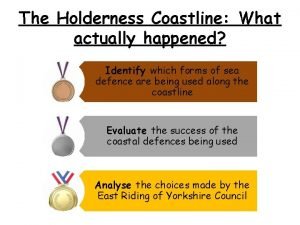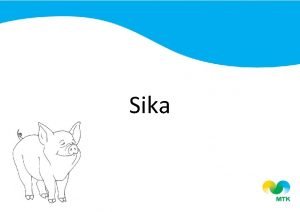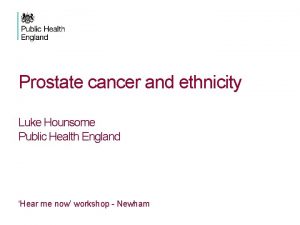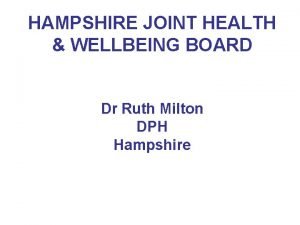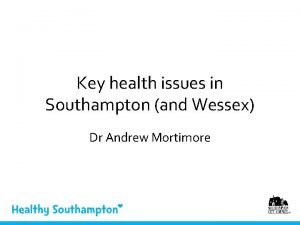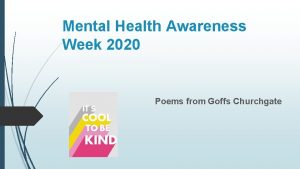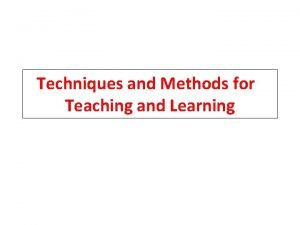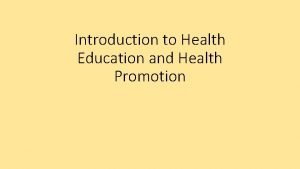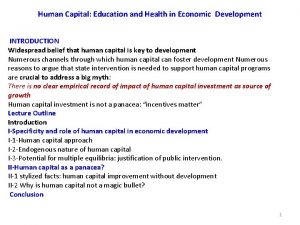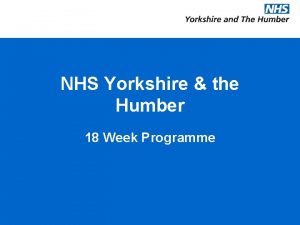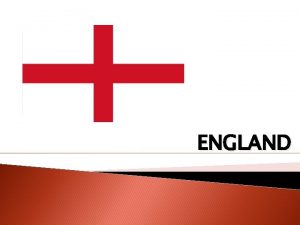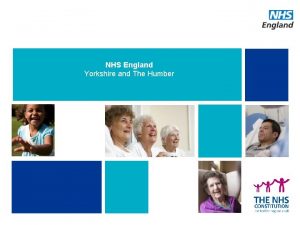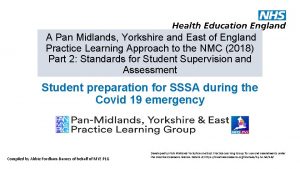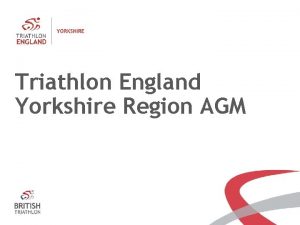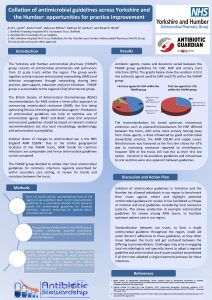IQI Day 1 Health education England across Yorkshire



























































- Slides: 59

IQI Day 1 Health education England across Yorkshire & Humber

Welcome @NHS_Health. Ed. Eng HEE across Yorkshire & Humber 2016 ©

Aim: Understand the basics of QI l By the end of the session: • Understand: – Quality in healthcare – What quality improvement is – What a quality improvement project (QIP) is – How to start making a change @NHS_Health. Ed. Eng HEE across Yorkshire & Humber 2016 ©

Overview 09. 00 09. 15 09. 30 10. 00 10. 45 11. 00 11. 40 12. 00 12. 15 12. 50 Introduction & welcome Patient Story What is quality and what is QI? The Model for Improvement Coffee Break Group activity: prototyping Tools for defining the problem Local Perspectives Quality is personal Project Closing and Feedback @NHS_Health. Ed. Eng HEE across Yorkshire & Humber 2016 ©

A patient’s story @NHS_Health. Ed. Eng HEE across Yorkshire & Humber 2016 ©

Part of the Yorkshire and Humber AHSN @NHS_Health. Ed. Eng HEE across Yorkshire & Humber 2016 ©

What had gone wrong? 1. Poor Communication • No plan given to patient re when to seek review • No info handed over to local team • Not brought in earlier/flagged up for review 2. When arrived not realised that she was PROM • Changed from low ->high risk • LW and active monitoring • ? speed up delivery 3. Swab in London- had grown GBS 1. ? Abx in labour 2. Lower threshold for looking for infection @NHS_Health. Ed. Eng HEE across Yorkshire & Humber 2016 ©

How would you feel? As the patient’s family? As the Doctor? @NHS_Health. Ed. Eng HEE across Yorkshire & Humber 2016 ©

Part of the Yorkshire and Humber AHSN How do organisations ‘improve’ themselves? Some thoughts. . . @NHS_Health. Ed. Eng HEE across Yorkshire & Humber 2016 ©

Part of the Yorkshire and Humber AHSN Thought number 1 Nobody goes to work to do ‘a bad job’. @NHS_Health. Ed. Eng HEE across Yorkshire & Humber 2016 ©

Part of the Yorkshire and Humber AHSN Thought number 2 Form follows function. . . but is this true in the NHS? @NHS_Health. Ed. Eng HEE across Yorkshire & Humber 2016 ©

Part of the Yorkshire and Humber AHSN Thought number 3 “Every system is perfectly designed to achieve exactly the results it gets. ” Donald Berwick So. . . if you want different results you have to change the system. @NHS_Health. Ed. Eng HEE across Yorkshire & Humber 2016 ©

Part of the Yorkshire and Humber AHSN Thought number 4 Not all ‘change’ = ‘improvement’ @NHS_Health. Ed. Eng HEE across Yorkshire & Humber 2016 ©

Part of the Yorkshire and Humber AHSN Thought number 5 How do we know when things are changing? We use objective measures: For example @NHS_Health. Ed. Eng HEE across Yorkshire & Humber 2016 ©

Part of the Yorkshire and Humber AHSN In Summary 1. BAD systems not people 2. The NHS has evolved incrementally - so it’s no-one’s ‘fault’ if systems don’t work well 3. Need to change system if we want to make the system better 4. We don’t always recognise the difference between ‘change’ and ‘improvement’ • objective ways to measure impact of change • Test our changes before we implement @NHS_Health. Ed. Eng HEE across Yorkshire & Humber 2016 ©

Part of the Yorkshire and Humber AHSN “Here is Edward Bear, coming downstairs now, bump, bump on the back of his head, behind Christopher Robin. It is, as far as he knows, the only way of coming downstairs, but sometimes he feels that there really is another way, if only he could stop bumping for a moment and think of it”. AA Milne – Winnie the Pooh @NHS_Health. Ed. Eng HEE across Yorkshire & Humber 2016 ©

What do we mean by quality in health care? @NHS_Health. Ed. Eng HEE across Yorkshire & Humber 2016 ©

Part of the Yorkshire and Humber AHSN Effectiveness No needless or suffering pain Equity For all Patient Centred No helplessness in those served or serving Quality Timeliness Efficiency No unwanted waiting No waste Safety No needless deaths @NHS_Health. Ed. Eng HEE across Yorkshire & Humber 2016 ©

Systems & Processes System: A collection or processes organised around a purpose Process: A series of work activities that transform inputs to Outputs for the benefit of someone The systems we work in are inherently complex *BUT when things go wrong we often focus on who to blame → remove the bad apple @NHS_Health. Ed. Eng HEE across Yorkshire & Humber 2016 ©

What is quality improvement? @NHS_Health. Ed. Eng HEE across Yorkshire & Humber 2016 ©

Part of the Yorkshire and Humber AHSN “QI is an organised system to continually improve processes, outcomes, and service, regardless of prior excellence, in order to be the best we can be. " – Brent C. James @NHS_Health. Ed. Eng HEE across Yorkshire & Humber 2016 ©

Part of the Yorkshire and Humber AHSN What does it REALLY mean? • An attempt to improve an aspect of the system we work in • Any attempt – the smaller the better • Any aspect – clinical or non-clinical • Anybody can do it (everybody should do it) @NHS_Health. Ed. Eng HEE across Yorkshire & Humber 2016 ©

Part of the Yorkshire and Humber AHSN Continuous improvement @NHS_Health. Ed. Eng HEE across Yorkshire & Humber 2016 ©

Part of the Yorkshire and Humber AHSN Usual approaches to change in a complex environment Trial & Error? Chaos Detailed prior study? Paralysis Too much action, not enough thinking Too much thinking not enough action Macho management Just going ahead and doing it “We can’t do anything until we know exactly what to do…” “Trial and Learning” Approach @NHS_Health. Ed. Eng HEE across Yorkshire & Humber 2016 ©

Audit Versus QIP Audit sits under the umbrella of Quality Improvement →BUT is often not used effectively to achieve improvement Audit QIP Data Endpoint Resource to show change needed/improvement made Method Scientific rigour Collaborative, learning Standards National clinical standards or guidelines Often no actual standards agreed in patients safety/experience or service Time to change Months weeks Review 6 months + or ? never Daily or weekly

Part of the Yorkshire and Humber AHSN The Model for Improvement @NHS_Health. Ed. Eng HEE across Yorkshire & Humber 2016 ©

Part of the Yorkshire and Humber AHSN Model for Improvement What are we trying to accomplish? How will we know that a change is an improvement? What change can we make that will result in improvement? @NHS_Health. Ed. Eng Act Plan Study Do Langley G, Nolan K, Nolan T, Norman C, Provost L, (1996), The improvement guide: a practical approach to enhancing organisational performance, Jossey Bass Publishers, San Francisco HEE across Yorkshire & Humber 2016 ©

Part of the Yorkshire and Humber AHSN Model for Improvement What are we trying to accomplish? How will we know that a change is an improvement? What change can we make that will result in improvement? @NHS_Health. Ed. Eng Act Plan Study Do Understanding the problem. Knowing what you’re trying to do - clear and desirable aims and objectives Langley G, Nolan K, Nolan T, Norman C, Provost L, (1996), The improvement guide: a practical approach to enhancing organisational performance, Jossey Bass Publishers, San Francisco HEE across Yorkshire & Humber 2016 ©

Part of the Yorkshire and Humber AHSN Set the aim: it should be • Time specific and measurable –i. e. ‘how much’ & ‘by when’ • Define specific group of patients affected • Agreed by the team • Resourced • Time framed @NHS_Health. Ed. Eng Clear enough to guide the work BUT grand enough to excite participants HEE across Yorkshire & Humber 2016 ©

Part of the Yorkshire and Humber AHSN Examples of how (not to) write an aim We will decrease falls by 20% P We will decrease falls on Ward 23 by 20% from baseline by the end of December 2015 Note: its is importance to have a clear operational definition. @NHS_Health. Ed. Eng HEE across Yorkshire & Humber 2016 ©

Part of the Yorkshire and Humber AHSN Model for Improvement What are we trying to accomplish? How will we know that a change is an improvement? What change can we make that will result in improvement? @NHS_Health. Ed. Eng Act Plan Study Do Measuring processes and outcomes Langley G, Nolan K, Nolan T, Norman C, Provost L, (1996), The improvement guide: a practical approach to enhancing organisational performance, Jossey Bass Publishers, San Francisco HEE across Yorkshire & Humber 2016 ©

Part of the Yorkshire and Humber AHSN Types of Measurement can be split into the reason why you are measuring: • Research • Performance Monitoring (Accountability) • Quality Improvement @NHS_Health. Ed. Eng HEE across Yorkshire & Humber 2016 ©

Three types of measurement Aspect Aim Improvement Accountability Improvement of care Comparison, choice, reassurance Methods Research New knowledge Tests are observable No test evaluation of current performance Test blinded or controlled tests Accept consistent bias Measure and adjust to reduce bias Design to eliminate bias Sample Size “Just enough” data, small sequential samples Obtain 100% of available, relevant data “Just in case” data Flexibility of Hypothesis Flexible, changes as learning takes place No hypothesis Fixed hypothesis Testing Strategy Sequential tests No tests One large test Determining if a Change is an Improvement Run charts or Shewhart control charts No change focus Hypothesis, statistical (p values) Data used only by those involved with improvement Data available for public consumption and review Research subjects’ identities protected Bias • Confidentiality of the Data HEE across Yorkshire & Humber 2016 ©

Part of the Yorkshire and Humber AHSN Three types of ‘measurement for improvement’ • Outcome measures • Process measures • Balancing measures @NHS_Health. Ed. Eng HEE across Yorkshire & Humber 2016 ©

Part of the Yorkshire and Humber AHSN (i) Outcome measure = How is the system performing? Think: • What to measure (and how) • How frequently • Establishing the baseline For example: Number of patients falling Daily Vs weekly @NHS_Health. Ed. Eng HEE across Yorkshire & Humber 2016 ©

Part of the Yorkshire and Humber AHSN (ii) Process measure(s) = Are the processes (parts/steps) in the system performing as planned? Think • What to measure (and how) • How frequently • Establishing the baseline • E. g. What % of patients received a falls risk assessment • How many times/day are we intentionally rounding ? @NHS_Health. Ed. Eng HEE across Yorkshire & Humber 2016 ©

Part of the Yorkshire and Humber AHSN (iii) Balancing measure(s) = Unintended consequences. Aka yes, but. . . . What would you worry about? @NHS_Health. Ed. Eng HEE across Yorkshire & Humber 2016 ©

Part of the Yorkshire and Humber AHSN Measurement: key points • Measures are used to guide improvement • Focus on the vital few • Try to integrate measurement into your routine • Define numerator and denominator 5/10 (50%) Vs 5/5 (100%) • Plot your data over time • Make run charts visible – they provide important feedback @NHS_Health. Ed. Eng HEE across Yorkshire & Humber 2016 ©

Part of the Yorkshire and Humber AHSN Why Run charts ? • Easier to assimilate info from charts than tables • Can display data to make performance visible • Determine if change resulted in improvement • Can see if ‘holding the gains’ made by improvement (sustaining) @NHS_Health. Ed. Eng HEE across Yorkshire & Humber 2016 ©

A simple run chart Number blood test by phlebs 14 12 Re-launch A simple run chart Expansion, L 10 first 10 8 Baseline data 6 4 2 0 1 3 5 7 9 11 13 15 17 19 21 23 25 27 29 31 33 35 37 39 41 43 45 47 49 51 53 55 57 59 61 63 65 67 69 71 73 75 77 79 81 83 85 87 89 91 Time, days @NHS_Health. Ed. Eng HEE across Yorkshire & Humber 2016 ©

Part of the Yorkshire and Humber AHSN Model for Improvement What are we trying to accomplish? How will we know that a change is an improvement? What change can we make that will result in improvement? @NHS_Health. Ed. Eng Act Plan Study Do What have others done? What hunches do we have? What can we learn as we go along? HEE across Yorkshire & Humber 2016 ©

Part of the Yorkshire and Humber AHSN Test your changes: the PDSA Cycle Act • What changes are to be made? • Next cycle? Study • Complete the analysis of the data • Compare data predictions • Summarize what was learned @NHS_Health. Ed. Eng Plan • Objective • Questions and predictions (why) • Plan to carry out the cycle (who, what, where, when) Do • Carry out the plan • Document problems and unexpected observations • Begin analysis of the data HEE across Yorkshire & Humber 2016 ©

Part of the Yorkshire and Humber AHSN Hunch Next ACT STUDY Reflection @NHS_Health. Ed. Eng PLAN DO Test HEE across Yorkshire & Humber 2016 ©

Part of the Yorkshire and Humber AHSN Why use PDSA? • Test change in real-time in the work place • Small rapid scale testing: – Minimises resistance – Will the change work in environment in question – Safe and low risk as refining change & checking works before implementing on a broader scale – 1, 3, 5, all! @NHS_Health. Ed. Eng HEE across Yorkshire & Humber 2016 ©

Part of the Yorkshire and Humber AHSN Developing Practice Improvement PDSA Problem Identified @NHS_Health. Ed. Eng A & e nc e lig tel PDSA s es n re a w sin a re c n I g In m a e T Change in Team Culture HEE across Yorkshire & Humber 2016 ©

Coffee Break @NHS_Health. Ed. Eng HEE across Yorkshire & Humber 2016 ©

@NHS_Health. Ed. Eng HEE across Yorkshire & Humber 2016 ©

http: //marshmallowchallenge. com/W elcome. html @NHS_Health. Ed. Eng HEE across Yorkshire & Humber 2016 ©

What did we learn? • Small steps • Test regularly • Learn from trials • Not all change is improvement @NHS_Health. Ed. Eng HEE across Yorkshire & Humber 2016 ©

Part of the Yorkshire and Humber AHSN Tools for defining the problem • Driver Diagrams • Spaghetti Diagrams • Fish bone diagram • Process mapping • 5 whys • Brainstorming • Mind maps @NHS_Health. Ed. Eng HEE across Yorkshire & Humber 2016 ©

Driver Diagram Primary drivers Reduce fuel price per gallon Secondary drivers Research cheapest fuel Aim/goal Decrease fuel costs Car share Reduce miles drive Increase efficiency (mpg) @NHS_Health. Ed. Eng Bike/walk to work Improve driving pattern ↓ rapid acceleration Use gears correctly ↓ rapid breaking Buy more efficient car HEE across Yorkshire & Humber 2016 ©

Spaghetti Diagram @NHS_Health. Ed. Eng HEE across Yorkshire & Humber 2016 ©

Fishbone (ishikawa) diagram People 2 people Day team practice Environment Hospital geography Play support, AHP Skills? Ametop/ cold spray Bloods done by night team Taxi to St James Sampling site Blood bottles Equipment @NHS_Health. Ed. Eng <2 yrs Requesting process, knowledge, planning Processes & policy HEE across Yorkshire & Humber 2016 ©

Process mapping Sent in batches to lab Patient referred to clinic Clinic sends letter Patient checks into clinic Pt sent to wait Arrives at hospital 30% appts rearranged @NHS_Health. Ed. Eng Blood sample taken 15 -30 mins Can’t park Hourly run INR tested Result to patient New appt made Result waits in queue Pt sent to wait 45 -90 mins 20 -30 mins Can’t find clinic 10 -15 mins HEE across Yorkshire & Humber 2016 ©

5 Whys • Write down what problem is and ask why? – If not solution ask why again and repeat Brainstorming • Non judgemental & non threatening environment • Gather list of spontaneous ideas @NHS_Health. Ed. Eng HEE across Yorkshire & Humber 2016 ©

Mind Map @NHS_Health. Ed. Eng HEE across Yorkshire & Humber 2016 ©

Local Perspectives + Looking at a problem: what frustrates & annoys you? @NHS_Health. Ed. Eng HEE across Yorkshire & Humber 2016 ©

Homework To bring to next session Your quality is personal project: Set an aim 2. Decide on your outcome measures 3. Collect your baseline measures 1. If not yet done: On-line ‘bronze’ training: http: //qitraining. improvementacademy. org/ @NHS_Health. Ed. Eng HEE across Yorkshire & Humber 2016 ©

Close and feedback: Aim: Understand the basics of QI By the end of the session: • Understand: – Quality in healthcare – What quality improvement is – What a quality improvement project (QIP) is – How to start making a change @NHS_Health. Ed. Eng HEE across Yorkshire & Humber 2016 ©
 Health education england yorkshire and humber
Health education england yorkshire and humber Ing direct toledo
Ing direct toledo Day 1 day 2 day 3 day 4
Day 1 day 2 day 3 day 4 Health education england organisational structure
Health education england organisational structure Health education england north west
Health education england north west Health education west midlands
Health education west midlands West yorkshire and harrogate health and care partnership
West yorkshire and harrogate health and care partnership Day 1 day 2 day 817
Day 1 day 2 day 817 Differences between health education and health promotion
Differences between health education and health promotion Health propaganda definition
Health propaganda definition Victorian school punishments
Victorian school punishments Yorkshire neonatal network
Yorkshire neonatal network Upgrq
Upgrq Yorkshire street pharmacy
Yorkshire street pharmacy Alcock v chief constable of south yorkshire
Alcock v chief constable of south yorkshire Flamborough head fossils
Flamborough head fossils Hampshire duroc yorkshire
Hampshire duroc yorkshire Aitchison labelling packaging network building
Aitchison labelling packaging network building Charlotte bronte born
Charlotte bronte born York eating disorders service
York eating disorders service Gmb yorkshire
Gmb yorkshire Map of east yorkshire coast
Map of east yorkshire coast Imisä
Imisä Mentor update yorkshire
Mentor update yorkshire Luke hounsome
Luke hounsome Wellbeing
Wellbeing Public health england
Public health england William beanes elementary
William beanes elementary Oceans apart day after day
Oceans apart day after day Day to day maintenance
Day to day maintenance Physical science chapter 6 review answers
Physical science chapter 6 review answers Tomorrow i don't know
Tomorrow i don't know Beautiful sunday evening
Beautiful sunday evening Growing day by day
Growing day by day Define seed dormancy
Define seed dormancy Germination conclusion
Germination conclusion Observation of plant growth day by day
Observation of plant growth day by day I live for jesus day after day
I live for jesus day after day Rising he justified freely forever
Rising he justified freely forever Day one day one noodle ss2
Day one day one noodle ss2 Dayone dayone noodles ss2 小時光 肆號麵鋪
Dayone dayone noodles ss2 小時光 肆號麵鋪 Mental health awareness poem
Mental health awareness poem World environment health day
World environment health day Formal and non formal education venn diagram
Formal and non formal education venn diagram Types of extension education
Types of extension education Hpe curriculum vic
Hpe curriculum vic Methods of health education
Methods of health education 10 importance of health education
10 importance of health education Example of nursing process
Example of nursing process Why is health education important
Why is health education important Principles of health education
Principles of health education Human capital education and health in economic development
Human capital education and health in economic development Principles of health education
Principles of health education Kinds of instructional materials
Kinds of instructional materials Definition for health education
Definition for health education Soil seed sower in health education
Soil seed sower in health education Concept of health education
Concept of health education Victorian curriculum health and physical education
Victorian curriculum health and physical education Gcche
Gcche Soil seed and sower in health education
Soil seed and sower in health education

